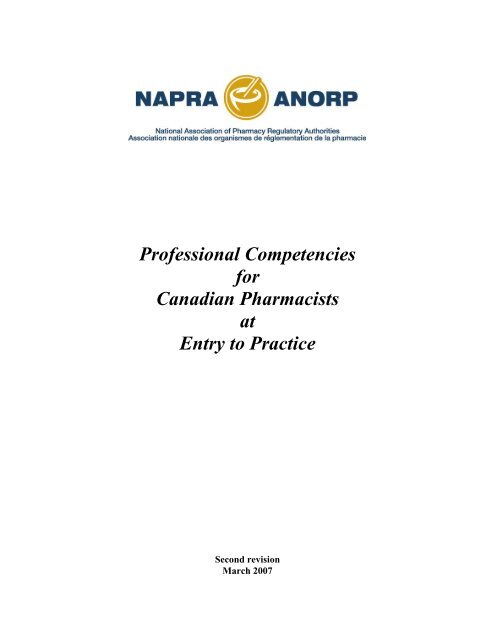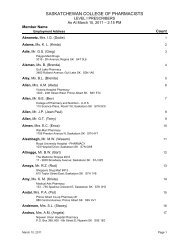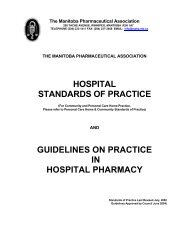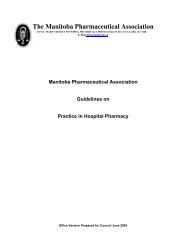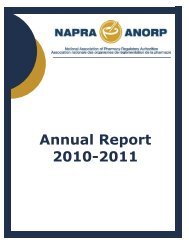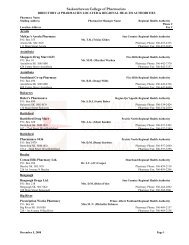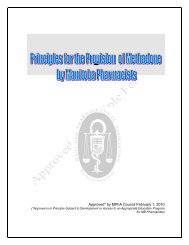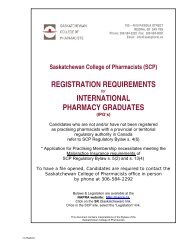Professional Competencies for Canadian Pharmacists at Entry to ...
Professional Competencies for Canadian Pharmacists at Entry to ...
Professional Competencies for Canadian Pharmacists at Entry to ...
You also want an ePaper? Increase the reach of your titles
YUMPU automatically turns print PDFs into web optimized ePapers that Google loves.
<strong>Professional</strong> <strong>Competencies</strong><br />
<strong>for</strong><br />
<strong>Canadian</strong> <strong>Pharmacists</strong><br />
<strong>at</strong><br />
<strong>Entry</strong> <strong>to</strong> Practice<br />
Second revision<br />
March 2007
©N<strong>at</strong>ional Associ<strong>at</strong>ion of Pharmacy Regul<strong>at</strong>ory Authorities, 2007. All rights reserved. No part of this document may be reproduced in any <strong>for</strong>m<br />
by any pho<strong>to</strong>graphic, electronic, mechanical or other means, or used in any in<strong>for</strong>m<strong>at</strong>ion s<strong>to</strong>rage and retrieval system, without the written<br />
permission of the author.<br />
The N<strong>at</strong>ional Associ<strong>at</strong>ion of Pharmacy Regul<strong>at</strong>ory Authorities (NAPRA), 220 Laurier Avenue West, Suite 750, Ottawa, ON K1P 5Z9<br />
(613) 569-9658 fax (613) 569-9659 e-mail: info@napra.ca<br />
<strong>Professional</strong> <strong>Competencies</strong> <strong>for</strong> <strong>Canadian</strong> <strong>Pharmacists</strong> <strong>at</strong> <strong>Entry</strong> <strong>to</strong> Practice 2
Background<br />
NAPRA was <strong>for</strong>med in February 1995 as an umbrella organiz<strong>at</strong>ion of Canada’s provincial<br />
pharmacy regul<strong>at</strong>ory bodies. The mission of our associ<strong>at</strong>ion is <strong>to</strong> facilit<strong>at</strong>e the activities of<br />
provincial pharmacy regul<strong>at</strong>ory authorities in their service of public interest. This is<br />
accomplished by:<br />
• representing the interests of the member organiz<strong>at</strong>ions;<br />
• serving as a n<strong>at</strong>ional resource centre; and<br />
• promoting the harmoniz<strong>at</strong>ion of legisl<strong>at</strong>ion and standards<br />
These n<strong>at</strong>ional competencies were originally developed in 1997 in response <strong>to</strong> the federal<br />
government’s Agreement on Internal Trade (AIT) which came in<strong>to</strong> effect in 1995. Chapter<br />
Seven of the AIT, the Labour Mobility Chapter, specifies th<strong>at</strong> any worker qualified <strong>for</strong> an<br />
occup<strong>at</strong>ion in one province or terri<strong>to</strong>ry should be granted access <strong>to</strong> employment in th<strong>at</strong><br />
occup<strong>at</strong>ion in any other province or terri<strong>to</strong>ry in Canada. One mechanism <strong>to</strong> facilit<strong>at</strong>e this is<br />
through the development of a mutual recognition agreement, especially if there is a high degree<br />
of commonality throughout the profession. These n<strong>at</strong>ional competencies are reflective of th<strong>at</strong><br />
commonality, and <strong>for</strong>m the basis of a N<strong>at</strong>ional Model Licensing Program which describes entry<br />
<strong>to</strong> practice requirements <strong>for</strong> initial licensing of pharmacists in jurisdictions th<strong>at</strong> are sign<strong>at</strong>ories <strong>to</strong><br />
the mutual recognition agreement.<br />
These competencies were revised by represent<strong>at</strong>ives of the pharmacy profession from all<br />
jurisdictions across Canada (except Yukon and Nunavut) during a workshop hosted by NAPRA<br />
in January 2007. In addition, they were reviewed by external stakeholders prior <strong>to</strong> being<br />
finalized and adopted by the NAPRA Board of Direc<strong>to</strong>rs. NAPRA thanks both workshop<br />
participants and stakeholders <strong>for</strong> their time and ef<strong>for</strong>ts in the revision of these competencies. In<br />
addition, many thanks <strong>to</strong> Kelly Piasentin of Assessment Str<strong>at</strong>egies Inc. of Ottawa <strong>for</strong> facilit<strong>at</strong>ing<br />
this process.<br />
<strong>Professional</strong> <strong>Competencies</strong> <strong>for</strong> <strong>Canadian</strong> <strong>Pharmacists</strong> <strong>at</strong> <strong>Entry</strong> <strong>to</strong> Practice 3
Contents<br />
Background 3<br />
<strong>Competencies</strong> of <strong>Entry</strong> Level <strong>Pharmacists</strong><br />
Competency C<strong>at</strong>egories 6<br />
Competency #1: P<strong>at</strong>ient Care<br />
Competency #2: <strong>Professional</strong> Collabor<strong>at</strong>ion and Team Work<br />
Competency #3: Ethical, Legal and <strong>Professional</strong> Responsibilities<br />
Competency #4: Drug, Therapeutic and Practice In<strong>for</strong>m<strong>at</strong>ion<br />
Competency #5: Communic<strong>at</strong>ion and Educ<strong>at</strong>ion<br />
Competency #6: Drug Distribution<br />
Competency #7: Management Knowledge and Skills<br />
Glossary of Terms<br />
Workshop Participants<br />
<strong>Professional</strong> <strong>Competencies</strong> <strong>for</strong> <strong>Canadian</strong> <strong>Pharmacists</strong> <strong>at</strong> <strong>Entry</strong> <strong>to</strong> Practice 4<br />
Page<br />
5<br />
7<br />
10<br />
11<br />
12<br />
13<br />
14<br />
15<br />
16<br />
18
<strong>Competencies</strong> of <strong>Entry</strong> Level <strong>Pharmacists</strong><br />
This document outlines the competencies 1 required of pharmacists <strong>at</strong> the point of licensure in<br />
Canada, <strong>for</strong> the benefit of the <strong>Canadian</strong> public.<br />
The competencies require as a minimum prerequisite the completion of an accredited 2<br />
baccalaure<strong>at</strong>e in pharmacy degree program. It is recognized th<strong>at</strong> the knowledge, skills and<br />
<strong>at</strong>titudes gained in the completion of an accredited program will provide the found<strong>at</strong>ion <strong>for</strong> all<br />
competencies.<br />
Through these competencies, pharmacists assist individuals and groups <strong>to</strong> achieve desired health<br />
outcomes by providing current, r<strong>at</strong>ional, safe and cost-effective pharmaceutical in<strong>for</strong>m<strong>at</strong>ion,<br />
products and services.<br />
In developing the list of competencies <strong>for</strong> pharmacists, the following assumptions were made:<br />
The Practice Environment:<br />
<strong>Pharmacists</strong> work in a wide variety of practice environments (e.g., community pharmacy,<br />
hospital/institutional pharmacy, educ<strong>at</strong>ion, research, consulting, family health centres, etc.)<br />
The P<strong>at</strong>ient 3 :<br />
Refers <strong>to</strong> any person or authorized agent <strong>to</strong> whom a pharmacist provides a service th<strong>at</strong> is within<br />
the practice of pharmacy. The agent refers <strong>to</strong> a family member, caregiver, or another person who<br />
has a close personal rel<strong>at</strong>ionship with the p<strong>at</strong>ient.<br />
The Health Care <strong>Professional</strong>:<br />
Refers <strong>to</strong> professionals within the p<strong>at</strong>ient’s circle of care 4 .<br />
The Pharmacist:<br />
Is a registered/licensed pharmacist who:<br />
- practices in accordance with professional registr<strong>at</strong>ion and licensure, and professional<br />
standards within his/her jurisdiction.<br />
- possesses both broad-based and pharmacy specific knowledge.<br />
- uses critical-thinking, problem-solving and decision-making skills appropri<strong>at</strong>e <strong>to</strong> the<br />
pharmacist role.<br />
- men<strong>to</strong>rs pharmacists, pharmacy students or interns, pharmacy technicians and others.<br />
- takes responsibility <strong>for</strong> his/her own continuing professional development 5 and commits <strong>to</strong><br />
life-long learning.<br />
1<br />
See glossary<br />
2<br />
See glossary<br />
3<br />
In this document, the terms ‘p<strong>at</strong>ient’ and ‘client’ are synonymous.<br />
4<br />
See glossary<br />
5<br />
See glossary<br />
<strong>Professional</strong> <strong>Competencies</strong> <strong>for</strong> <strong>Canadian</strong> <strong>Pharmacists</strong> <strong>at</strong> <strong>Entry</strong> <strong>to</strong> Practice 5
Competency C<strong>at</strong>egories<br />
P<strong>at</strong>ient Care<br />
<strong>Pharmacists</strong>, in partnership with p<strong>at</strong>ients and other health care professionals, use their unique<br />
knowledge and skills <strong>to</strong> meet p<strong>at</strong>ients’ drug and health rel<strong>at</strong>ed needs and <strong>to</strong> achieve optimal<br />
p<strong>at</strong>ient outcomes and p<strong>at</strong>ient safety.<br />
<strong>Professional</strong> Collabor<strong>at</strong>ion and Team Work<br />
<strong>Pharmacists</strong> work in collabor<strong>at</strong>ion with other health care professionals <strong>to</strong> optimize p<strong>at</strong>ient safety<br />
and improve health outcomes.<br />
Ethical, Legal and <strong>Professional</strong> Responsibilities<br />
<strong>Pharmacists</strong> practise within legal requirements, demonstr<strong>at</strong>e professional integrity and act <strong>to</strong><br />
uphold professional standards of practice and codes of ethics.<br />
Drug, Therapeutic and Practice In<strong>for</strong>m<strong>at</strong>ion<br />
<strong>Pharmacists</strong> assume responsibility <strong>for</strong> accessing, retrieving, evalu<strong>at</strong>ing and exchanging relevant<br />
in<strong>for</strong>m<strong>at</strong>ion <strong>to</strong> ensure safe and effective p<strong>at</strong>ient care.<br />
Communic<strong>at</strong>ion and Educ<strong>at</strong>ion<br />
<strong>Pharmacists</strong> communic<strong>at</strong>e with and provide educ<strong>at</strong>ion <strong>to</strong> groups and individuals in order <strong>to</strong><br />
promote and support optimal p<strong>at</strong>ient care and well-being.<br />
Drug Distribution<br />
<strong>Pharmacists</strong> manage the drug distribution system <strong>to</strong> ensure the safety, accuracy and quality of<br />
supplied products.<br />
Understanding Management Principles<br />
<strong>Pharmacists</strong> apply knowledge, principles and skills of management with the goal of optimizing<br />
p<strong>at</strong>ient care and inter-professional rel<strong>at</strong>ionships.<br />
<strong>Professional</strong> <strong>Competencies</strong> <strong>for</strong> <strong>Canadian</strong> <strong>Pharmacists</strong> <strong>at</strong> <strong>Entry</strong> <strong>to</strong> Practice 6
Competency #1: P<strong>at</strong>ient Care<br />
Competency Unit 6<br />
Competency Elements 7 :<br />
1.1 Develop a trusting professional rel<strong>at</strong>ionship with the p<strong>at</strong>ient where both parties are<br />
interacting in a way where the oblig<strong>at</strong>ions, expected benefits, and consequences are<br />
clearly defined.<br />
i. establish and maintain rapport by using effective communic<strong>at</strong>ion skills.<br />
ii. demonstr<strong>at</strong>e a caring, emp<strong>at</strong>hetic, and professional <strong>at</strong>titude.<br />
iii. elicit the p<strong>at</strong>ient’s needs, values and desired level of care and desired outcomes<br />
regarding drug therapy.<br />
iv. assess the impact of fac<strong>to</strong>rs th<strong>at</strong> facilit<strong>at</strong>e or impede the health of individual<br />
p<strong>at</strong>ients.<br />
v. define mutual oblig<strong>at</strong>ions, expected benefits, and consequences.<br />
1.2 G<strong>at</strong>her p<strong>at</strong>ient in<strong>for</strong>m<strong>at</strong>ion.<br />
i. identify and use appropri<strong>at</strong>e sources of in<strong>for</strong>m<strong>at</strong>ion (e.g., p<strong>at</strong>ient, labor<strong>at</strong>ory d<strong>at</strong>a,<br />
chart, electronic health record, profile, other health care professionals, etc.).<br />
ii. actively listen and interpret the in<strong>for</strong>m<strong>at</strong>ion provided (e.g., medical and social<br />
his<strong>to</strong>ry, adverse drug reactions, allergies, medic<strong>at</strong>ion use, etc.).<br />
iii. assess the relevance of the in<strong>for</strong>m<strong>at</strong>ion.<br />
1.3 Assess the health st<strong>at</strong>us and concerns of the p<strong>at</strong>ient.<br />
i. use appropri<strong>at</strong>e d<strong>at</strong>a, techniques and procedures <strong>to</strong> assess the p<strong>at</strong>ient’s health.<br />
ii. use knowledge base <strong>to</strong> comprehend the scope and breadth of the p<strong>at</strong>ient’s health<br />
problem.<br />
iii. identify fac<strong>to</strong>rs (e.g., risk fac<strong>to</strong>rs, financial, lifestyle, nutrition) th<strong>at</strong> impact on the<br />
therapeutic outcome.<br />
6 See glossary<br />
7 See glossary<br />
<strong>Pharmacists</strong>, in partnership with p<strong>at</strong>ients and other health care professionals, use<br />
their unique knowledge and skills <strong>to</strong> meet p<strong>at</strong>ients’ drug and health rel<strong>at</strong>ed needs<br />
and <strong>to</strong> achieve optimal p<strong>at</strong>ient outcomes and p<strong>at</strong>ient safety.<br />
<strong>Professional</strong> <strong>Competencies</strong> <strong>for</strong> <strong>Canadian</strong> <strong>Pharmacists</strong> <strong>at</strong> <strong>Entry</strong> <strong>to</strong> Practice 7
1.4 Identify the p<strong>at</strong>ient’s desired therapeutic outcomes.<br />
i. integr<strong>at</strong>e knowledge of the p<strong>at</strong>ient’s health st<strong>at</strong>us with knowledge of drug and<br />
non-drug tre<strong>at</strong>ment options.<br />
ii. outline the benefits and/or consequences of the tre<strong>at</strong>ment options.<br />
iii. enable the p<strong>at</strong>ient <strong>to</strong> make choices.<br />
1.5 Identify and prioritize actual and potential drug therapy problems <strong>to</strong> determine if:<br />
i. the p<strong>at</strong>ient requires drug therapy but is not receiving it,<br />
ii. the p<strong>at</strong>ient is taking or receiving the wrong drug,<br />
iii. the p<strong>at</strong>ient is taking or receiving <strong>to</strong>o little of the right drug,<br />
iv. the p<strong>at</strong>ient is taking or receiving <strong>to</strong>o much of the right drug,<br />
iv. the p<strong>at</strong>ient is not taking or receiving the drug or is taking or receiving the drug<br />
inappropri<strong>at</strong>ely,<br />
v. the p<strong>at</strong>ient is experiencing an adverse reaction <strong>to</strong> the drug,<br />
vi. the p<strong>at</strong>ient is experiencing a drug interaction (including drug-drug, drug-food,<br />
drug-labor<strong>at</strong>ory test, drug-disease, or drug-blood product),<br />
vii. the p<strong>at</strong>ient is taking or receiving a drug <strong>for</strong> no medically valid indic<strong>at</strong>ion or<br />
substance abuse.<br />
1.6 Develop a therapeutic plan.<br />
i. identify and assess tre<strong>at</strong>ment str<strong>at</strong>egies, including drug and non drug measures 8<br />
using an evidence-in<strong>for</strong>med 9 approach.<br />
ii. select therapeutic options.<br />
iii. recognize, solve and prevent actual and potential drug therapy problems.<br />
iv. consult with the p<strong>at</strong>ient and, if necessary, health care professionals.<br />
1.7 Support the implement<strong>at</strong>ion of the therapeutic plan.<br />
i. explain the r<strong>at</strong>ionale <strong>for</strong> the proposed tre<strong>at</strong>ment.<br />
ii. provide p<strong>at</strong>ient educ<strong>at</strong>ion (e.g., counseling in<strong>for</strong>m<strong>at</strong>ion and educ<strong>at</strong>ion on<br />
adherence issues, either verbal or written).<br />
iii. assess p<strong>at</strong>ient’s understanding of the therapeutic plan.<br />
1.8 Moni<strong>to</strong>r the p<strong>at</strong>ient’s progress and assess therapeutic outcomes.<br />
i. recognize the important clinical indic<strong>at</strong>ors (e.g., signs and symp<strong>to</strong>ms, labor<strong>at</strong>ory<br />
tests, adverse effects).<br />
ii. identify and apply moni<strong>to</strong>ring/intervention techniques and timelines.<br />
iii. specify outcomes with measurable therapeutic end points.<br />
iv. discuss with the p<strong>at</strong>ient the ongoing responsibilities of the pharmacist, p<strong>at</strong>ient and<br />
other health care professionals.<br />
v. assess <strong>to</strong>lerance and safety of therapy.<br />
vi. assess adherence <strong>to</strong> therapy.<br />
vii. conduct follow-up consult<strong>at</strong>ion(s) <strong>to</strong> evalu<strong>at</strong>e the therapeutic effectiveness.<br />
8 See glossary<br />
9 See Glossary<br />
<strong>Professional</strong> <strong>Competencies</strong> <strong>for</strong> <strong>Canadian</strong> <strong>Pharmacists</strong> <strong>at</strong> <strong>Entry</strong> <strong>to</strong> Practice 8
Competency #2: <strong>Professional</strong> Collabor<strong>at</strong>ion and Team Work<br />
Competency Unit<br />
Competency Elements:<br />
2.1 Develop collabor<strong>at</strong>ive rel<strong>at</strong>ionships 10 with health care professionals such th<strong>at</strong> the<br />
oblig<strong>at</strong>ions and expected benefits are clearly defined.<br />
2.2 Cooper<strong>at</strong>e with and show respect <strong>for</strong> all members of the inter-professional team.<br />
i. make expertise available <strong>to</strong> others.<br />
ii. share relevant in<strong>for</strong>m<strong>at</strong>ion.<br />
iii. contribute <strong>to</strong> defining objectives shared by all professions concerned.<br />
iv. support other professionals and accept their support <strong>to</strong> optimize health outcomes.<br />
2.3 Refer p<strong>at</strong>ients <strong>to</strong> other health care providers when required.<br />
i. determine if a referral is necessary.<br />
ii. identify the most appropri<strong>at</strong>e health care provider or agency <strong>for</strong> the referral (e.g., medical<br />
or social).<br />
iii. work with other health care providers <strong>to</strong> determine the desired therapeutic outcome.<br />
2.4 Work with other health care professionals <strong>to</strong> promote health and wellness in the<br />
community.<br />
2.5 Contribute <strong>to</strong> the discovery of new knowledge and skills (e.g., particip<strong>at</strong>ing in<br />
collabor<strong>at</strong>ive health rel<strong>at</strong>ed research).<br />
2.6 Understand, particip<strong>at</strong>e in and promote safety initi<strong>at</strong>ives (e.g., medic<strong>at</strong>ion safety,<br />
continuity of care).<br />
10 See glossary<br />
<strong>Pharmacists</strong> work in collabor<strong>at</strong>ion with other health care professionals <strong>to</strong> optimize<br />
p<strong>at</strong>ient safety and improve health outcomes.<br />
<strong>Professional</strong> <strong>Competencies</strong> <strong>for</strong> <strong>Canadian</strong> <strong>Pharmacists</strong> <strong>at</strong> <strong>Entry</strong> <strong>to</strong> Practice 10
Competency #3: Ethical, Legal and <strong>Professional</strong> Responsibilities<br />
Competency Unit:<br />
Competency Elements:<br />
3.1 Apply legal and ethical requirements including federal and provincial/terri<strong>to</strong>rial<br />
legisl<strong>at</strong>ion 11 , policies, by-laws and standards.<br />
3.2 Uphold and act on the ethical principle th<strong>at</strong> a pharmacist’s primary accountability is <strong>to</strong><br />
the p<strong>at</strong>ient.<br />
i. ensure p<strong>at</strong>ient confidentiality.<br />
ii. advoc<strong>at</strong>e on behalf of the p<strong>at</strong>ient.<br />
iii. involve the p<strong>at</strong>ient in decision-making.<br />
iv. respect the rights of p<strong>at</strong>ients <strong>to</strong> make their own choices.<br />
v. consider p<strong>at</strong>ient-specific circumstances.<br />
3.3 Demonstr<strong>at</strong>e personal and professional integrity.<br />
i. accept responsibility <strong>for</strong> actions and decisions.<br />
ii. show respect <strong>for</strong> the dignity of the p<strong>at</strong>ient.<br />
iii. maintain appropri<strong>at</strong>e professional boundaries.<br />
iv. practise within personal limits of knowledge, skills and abilities.<br />
3.4 Demonstr<strong>at</strong>e an understanding of the <strong>Canadian</strong> health care system and the role of the<br />
pharmacist and other health care professionals within it.<br />
3.5 Demonstr<strong>at</strong>e an understanding of the importance of and the process of continuing<br />
professional development.<br />
i. assess own learning needs.<br />
ii. develop a plan <strong>to</strong> meet learning needs.<br />
iii. seek and evalu<strong>at</strong>e learning opportunities <strong>to</strong> enhance practice.<br />
iv. incorpor<strong>at</strong>e learning in<strong>to</strong> practice.<br />
11 See glossary<br />
<strong>Pharmacists</strong> practise within legal requirements, demonstr<strong>at</strong>e professional<br />
integrity and act <strong>to</strong> uphold professional standards of practice and codes of<br />
ethics.<br />
<strong>Professional</strong> <strong>Competencies</strong> <strong>for</strong> <strong>Canadian</strong> <strong>Pharmacists</strong> <strong>at</strong> <strong>Entry</strong> <strong>to</strong> Practice 11
Competency #4: Drug, Therapeutic and Practice In<strong>for</strong>m<strong>at</strong>ion<br />
Competency Unit:<br />
Competency Elements:<br />
4.1 Clearly define the question(s) <strong>to</strong> be researched.<br />
i. clarify requests <strong>for</strong> in<strong>for</strong>m<strong>at</strong>ion.<br />
ii. identify key targets (audiences).<br />
4.2 Identify appropri<strong>at</strong>e sources of relevant in<strong>for</strong>m<strong>at</strong>ion, using evidence-in<strong>for</strong>med approaches<br />
where possible.<br />
i. name major sources of in<strong>for</strong>m<strong>at</strong>ion.<br />
ii. determine the appropri<strong>at</strong>eness of these sources.<br />
iii. assess the value of the sources.<br />
4.3 Retrieve in<strong>for</strong>m<strong>at</strong>ion from relevant sources.<br />
i. use a variety of retrieval techniques <strong>to</strong> access relevant in<strong>for</strong>m<strong>at</strong>ion.<br />
ii. assess the suitability and reliability of these techniques.<br />
4.4 Evalu<strong>at</strong>e scientific in<strong>for</strong>m<strong>at</strong>ion.<br />
i. assess the adequacy of research design (e.g., ethics, methodology, etc.).<br />
ii. assess the relevance, applicability, accuracy, reliability, validity and<br />
generalizability of in<strong>for</strong>m<strong>at</strong>ion.<br />
4.5 Organize in<strong>for</strong>m<strong>at</strong>ion and develop a knowledge exchange 12 str<strong>at</strong>egy.<br />
i. determine key messages.<br />
ii. identify barriers <strong>to</strong> uptake.<br />
iii. identify target audience.<br />
iv. determine and apply methods <strong>for</strong> knowledge exchange.<br />
v. assess outcomes of the knowledge exchange.<br />
4.6 Identify issues in pharmacy practice and drug utiliz<strong>at</strong>ion.<br />
i. interpret in<strong>for</strong>m<strong>at</strong>ion in order <strong>to</strong> address issues in individual pharmacy practice.<br />
ii. use findings <strong>to</strong> improve practice.<br />
iii. communic<strong>at</strong>e results <strong>to</strong> appropri<strong>at</strong>e audiences.<br />
12 See glossary<br />
<strong>Pharmacists</strong> assume responsibility <strong>for</strong> accessing, retrieving, evalu<strong>at</strong>ing and<br />
exchanging relevant in<strong>for</strong>m<strong>at</strong>ion <strong>to</strong> ensure safe and effective p<strong>at</strong>ient care.<br />
<strong>Professional</strong> <strong>Competencies</strong> <strong>for</strong> <strong>Canadian</strong> <strong>Pharmacists</strong> <strong>at</strong> <strong>Entry</strong> <strong>to</strong> Practice 12
Competency #5: Communic<strong>at</strong>ion and Educ<strong>at</strong>ion<br />
Competency Unit:<br />
<strong>Pharmacists</strong> communic<strong>at</strong>e with and provide educ<strong>at</strong>ion <strong>to</strong> groups and<br />
individuals in order <strong>to</strong> promote and support optimal p<strong>at</strong>ient care and wellbeing.<br />
Competency Elements:<br />
5.1 Demonstr<strong>at</strong>e effective communic<strong>at</strong>ion skills.<br />
i. demonstr<strong>at</strong>e comprehension and proficiency in written and verbal English or<br />
French.<br />
ii. demonstr<strong>at</strong>e appropri<strong>at</strong>e verbal, non-verbal and listening skills.<br />
iii. demonstr<strong>at</strong>e effective interview techniques.<br />
iv. display clear, concise and effective writing skills.<br />
v. select appropri<strong>at</strong>e communic<strong>at</strong>ion techniques <strong>for</strong> use with p<strong>at</strong>ients and other<br />
health care professionals.<br />
5.2 Demonstr<strong>at</strong>e sensitivity, respect and emp<strong>at</strong>hy when communic<strong>at</strong>ing with diverse groups<br />
or individuals.<br />
i. demonstr<strong>at</strong>e an understanding of the impact th<strong>at</strong> individual differences have on<br />
communic<strong>at</strong>ion.<br />
5.3 Optimize individual and group health and wellness through educ<strong>at</strong>ion and health<br />
promotion.<br />
i. use knowledge base <strong>to</strong> discuss health care issues and public health priorities.<br />
ii. identify fac<strong>to</strong>rs th<strong>at</strong> are barriers <strong>to</strong>, or facilit<strong>at</strong>ors of, health and wellness in<br />
individuals and groups.<br />
iii. collabor<strong>at</strong>e with p<strong>at</strong>ients and other health care professionals in the development<br />
and implement<strong>at</strong>ion of health promotion str<strong>at</strong>egies and public health initi<strong>at</strong>ives.<br />
5.4 Design, implement and evalu<strong>at</strong>e an educ<strong>at</strong>ion plan <strong>for</strong> individuals and groups.<br />
i. identify the learning needs of participants.<br />
ii. assess personal abilities <strong>to</strong> carry out a particular educ<strong>at</strong>ional plan.<br />
iii. select educ<strong>at</strong>ional methods th<strong>at</strong> are appropri<strong>at</strong>e <strong>for</strong> the learner(s).<br />
iv. implement an educ<strong>at</strong>ional plan <strong>for</strong> individual or groups.<br />
v. assess outcomes.<br />
<strong>Professional</strong> <strong>Competencies</strong> <strong>for</strong> <strong>Canadian</strong> <strong>Pharmacists</strong> <strong>at</strong> <strong>Entry</strong> <strong>to</strong> Practice 13
Competency #6: Drug Distribution<br />
Competency Unit:<br />
Competency Elements:<br />
6.1 Apply relevant knowledge in the per<strong>for</strong>mance of tasks rel<strong>at</strong>ed <strong>to</strong>:<br />
i. interpret<strong>at</strong>ion of drug orders and/or prescriptions,<br />
ii. identific<strong>at</strong>ion of bioequivalency and interchangeability of multi-source drugs,<br />
iii. per<strong>for</strong>mance of pharmaceutical calcul<strong>at</strong>ions,<br />
iv. selection of quality products and ingredients,<br />
v. demonstr<strong>at</strong>ion of compounding and dispensing, including labeling,<br />
vi. prepar<strong>at</strong>ion of sterile products,<br />
vii. identific<strong>at</strong>ion of s<strong>to</strong>rage and handling conditions <strong>to</strong> ensure stability,<br />
viii. acquiring and disposing of drugs,<br />
ix. administr<strong>at</strong>ion of drugs,<br />
x. document<strong>at</strong>ion.<br />
6.2 Demonstr<strong>at</strong>e ability <strong>to</strong> supervise drug distribution.<br />
i. maintain safe and effective systems of drug supply and distribution.<br />
ii. adhere <strong>to</strong> distribution policies and procedures.<br />
iii. supervise support staff.<br />
6.3 Particip<strong>at</strong>e in continuous quality assurance.<br />
i respond <strong>to</strong> actual or potential problems within the drug distribution system.<br />
ii. acknowledge the problem.<br />
iii. take steps <strong>to</strong> assess and resolve issues arising from the problem.<br />
iv. implement measures <strong>to</strong> prevent occurrences or reoccurrences.<br />
v. document and report the problem and resolution.<br />
6.4 Moni<strong>to</strong>r drug distribution p<strong>at</strong>terns.<br />
i. recognize and respond <strong>to</strong> p<strong>at</strong>terns of unusual drug distribution (e.g., diversion,<br />
drug misuse, fluctu<strong>at</strong>ions in utiliz<strong>at</strong>ion, etc.).<br />
13 See glossary.<br />
<strong>Pharmacists</strong> manage the drug distribution system 13 <strong>to</strong> ensure the safety,<br />
accuracy and quality of supplied products.<br />
<strong>Professional</strong> <strong>Competencies</strong> <strong>for</strong> <strong>Canadian</strong> <strong>Pharmacists</strong> <strong>at</strong> <strong>Entry</strong> <strong>to</strong> Practice 14
Competency #7: Understanding Management Principles<br />
Competency Unit:<br />
Competency Elements:<br />
7.1 Supervise personnel such th<strong>at</strong> deleg<strong>at</strong>ed functions are carried out <strong>to</strong> meet accepted<br />
standards.<br />
i. apply management principles and skills relevant <strong>to</strong> human and physical<br />
resources.<br />
ii. define accepted standards, policies and procedures.<br />
iii. demonstr<strong>at</strong>e the principles of effective inter-professional and intra-professional<br />
working rel<strong>at</strong>ionships.<br />
7.2 Effectively manage workflow.<br />
i. demonstr<strong>at</strong>e organiz<strong>at</strong>ional skills.<br />
ii. prioritize and organize workflow.<br />
iii. demonstr<strong>at</strong>e time management skills.<br />
7.3 Understand management principles pertaining <strong>to</strong> pharmacy practice including:<br />
i. financial resources,<br />
ii. inven<strong>to</strong>ry,<br />
iii. in<strong>for</strong>m<strong>at</strong>ion resources (e.g., reference library, in<strong>for</strong>m<strong>at</strong>ion technology, legal<br />
documents, etc.),<br />
iv. human resources,<br />
v. quality assurance 14 .<br />
7.4 Interpret and apply the drug utiliz<strong>at</strong>ion, reimbursement and pharmacoeconomic policies<br />
of health care facilities, agencies and third party payment plans (e.g., generic substitution,<br />
therapeutic interchange, use of <strong>for</strong>mularies, co-payments, deductibles, prescription<br />
quantity limits, etc.).<br />
14 See glossary.<br />
<strong>Pharmacists</strong> apply knowledge, principles and skills of management with<br />
the goal of optimizing p<strong>at</strong>ient care and inter-professional rel<strong>at</strong>ionships.<br />
<strong>Professional</strong> <strong>Competencies</strong> <strong>for</strong> <strong>Canadian</strong> <strong>Pharmacists</strong> <strong>at</strong> <strong>Entry</strong> <strong>to</strong> Practice 15
Glossary of Terms<br />
Accredited 2<br />
Accredited by the <strong>Canadian</strong> Council <strong>for</strong> Accredit<strong>at</strong>ion of Pharmacy Programs (CCAPP), or<br />
Accredited by a body recognized by CCAPP, or<br />
Determined <strong>to</strong> be equivalent <strong>to</strong> a CCAPP accredited program by a Provincial Pharmacy Regul<strong>at</strong>ory<br />
Authority, or<br />
Determined <strong>to</strong> be equivalent <strong>to</strong> a CCAPP accredited program by the Pharmacy Examining Board of Canada<br />
(PEBC).<br />
Circle of care 4<br />
Term of reference used <strong>to</strong> describe all members of the health care team who have direct<br />
responsibilities of providing care <strong>to</strong> an individual.<br />
Collabor<strong>at</strong>ive Rel<strong>at</strong>ionship 10<br />
A rel<strong>at</strong>ionship between two or more health professionals th<strong>at</strong> is developed <strong>to</strong>:<br />
- facilit<strong>at</strong>e communic<strong>at</strong>ion<br />
- determine mutual goals of therapy th<strong>at</strong> are acceptable <strong>to</strong> the p<strong>at</strong>ient<br />
- share relevant health in<strong>for</strong>m<strong>at</strong>ion<br />
- establish the expect<strong>at</strong>ions of each participant<br />
<strong>Competencies</strong> 1<br />
Significant job rel<strong>at</strong>ed knowledge, skills, abilities, <strong>at</strong>titudes, and/or judgments required <strong>for</strong> competent<br />
per<strong>for</strong>mance by members of the profession.<br />
Competency Element 7<br />
A sub-section of a competency unit providing a detailed description of the key indic<strong>at</strong>ors of the expected<br />
activity.<br />
Competency Unit 6<br />
A major segment of an overall competency th<strong>at</strong> describes the key indic<strong>at</strong>ors of the expected activity.<br />
Continuing <strong>Professional</strong> Development 5<br />
The means by which individual pharmacists maintain and enhance their own competence.<br />
<strong>Professional</strong> <strong>Competencies</strong> <strong>for</strong> <strong>Canadian</strong> <strong>Pharmacists</strong> <strong>at</strong> <strong>Entry</strong> <strong>to</strong> Practice 16
Drug distribution system 13<br />
A system designed <strong>to</strong> facilit<strong>at</strong>e the safe transfer of a medic<strong>at</strong>ion from the manufacturer <strong>to</strong> the<br />
p<strong>at</strong>ient in a manner th<strong>at</strong> preserves both the integrity of the medic<strong>at</strong>ion and the safety of the<br />
p<strong>at</strong>ient. Steps in the drug distribution system include manufacturing, s<strong>to</strong>rage, procurement,<br />
dispensing, administr<strong>at</strong>ion, and returns.<br />
Evidence-in<strong>for</strong>med 9<br />
The conscientious, explicit and judicious use of current best evidence in making decisions about<br />
the care of individual p<strong>at</strong>ients.<br />
Knowledge Exchange 12<br />
Collabor<strong>at</strong>ive problem-solving between pharmacists and other individuals th<strong>at</strong> happens through<br />
linkage and exchange. Effective knowledge exchange involves interaction between pharmacists<br />
and other individuals and results in mutual learning through the process of planning, producing,<br />
dissemin<strong>at</strong>ing, and applying existing or new research in decision-making.<br />
Legisl<strong>at</strong>ion 11<br />
Includes st<strong>at</strong>utes and regul<strong>at</strong>ions made under those st<strong>at</strong>utes.<br />
Non drug measures 9<br />
Measures (in addition <strong>to</strong> drugs) th<strong>at</strong> can be used <strong>to</strong> assist in the tre<strong>at</strong>ment of health conditions.<br />
Quality Assurance 14<br />
The technical, oper<strong>at</strong>ional and managerial activities aiming <strong>to</strong> ensure th<strong>at</strong> all services reaching the p<strong>at</strong>ient<br />
are safe, effective and acceptable.<br />
<strong>Professional</strong> <strong>Competencies</strong> <strong>for</strong> <strong>Canadian</strong> <strong>Pharmacists</strong> <strong>at</strong> <strong>Entry</strong> <strong>to</strong> Practice 17
Neila Auld, Prince Edward Island Pharmacy Board<br />
Workshop Participants<br />
Lt. Col. Dave Cecillon, <strong>Canadian</strong> Forces Health Services<br />
Darwin Cheasley, Mani<strong>to</strong>ba Pharmaceutical Associ<strong>at</strong>ion<br />
Dale Cooney, Alberta College of <strong>Pharmacists</strong><br />
Della Croteau, Ontario College of <strong>Pharmacists</strong><br />
Cindy Dolynny, Northwest Terri<strong>to</strong>ries<br />
Jeanne Eriksen, Sask<strong>at</strong>chewan College of <strong>Pharmacists</strong><br />
Juan Edwards, Newfoundland and Labrador Pharmacy Board<br />
Stephen Graham, Nova Scotia College of <strong>Pharmacists</strong><br />
Susan Mansour, Associ<strong>at</strong>ion of Faculties of Pharmacy of Canada<br />
Marshall Moleschi, College of <strong>Pharmacists</strong> of British Columbia<br />
Josée Morin, Ordre des Pharmaciens du Québec<br />
Bill Veniot, New Brunswick Pharmaceutical Society<br />
Karen Wolfe, N<strong>at</strong>ional Associ<strong>at</strong>ion of Pharmacy Regul<strong>at</strong>ory Authorities<br />
<strong>Professional</strong> <strong>Competencies</strong> <strong>for</strong> <strong>Canadian</strong> <strong>Pharmacists</strong> <strong>at</strong> <strong>Entry</strong> <strong>to</strong> Practice 18


